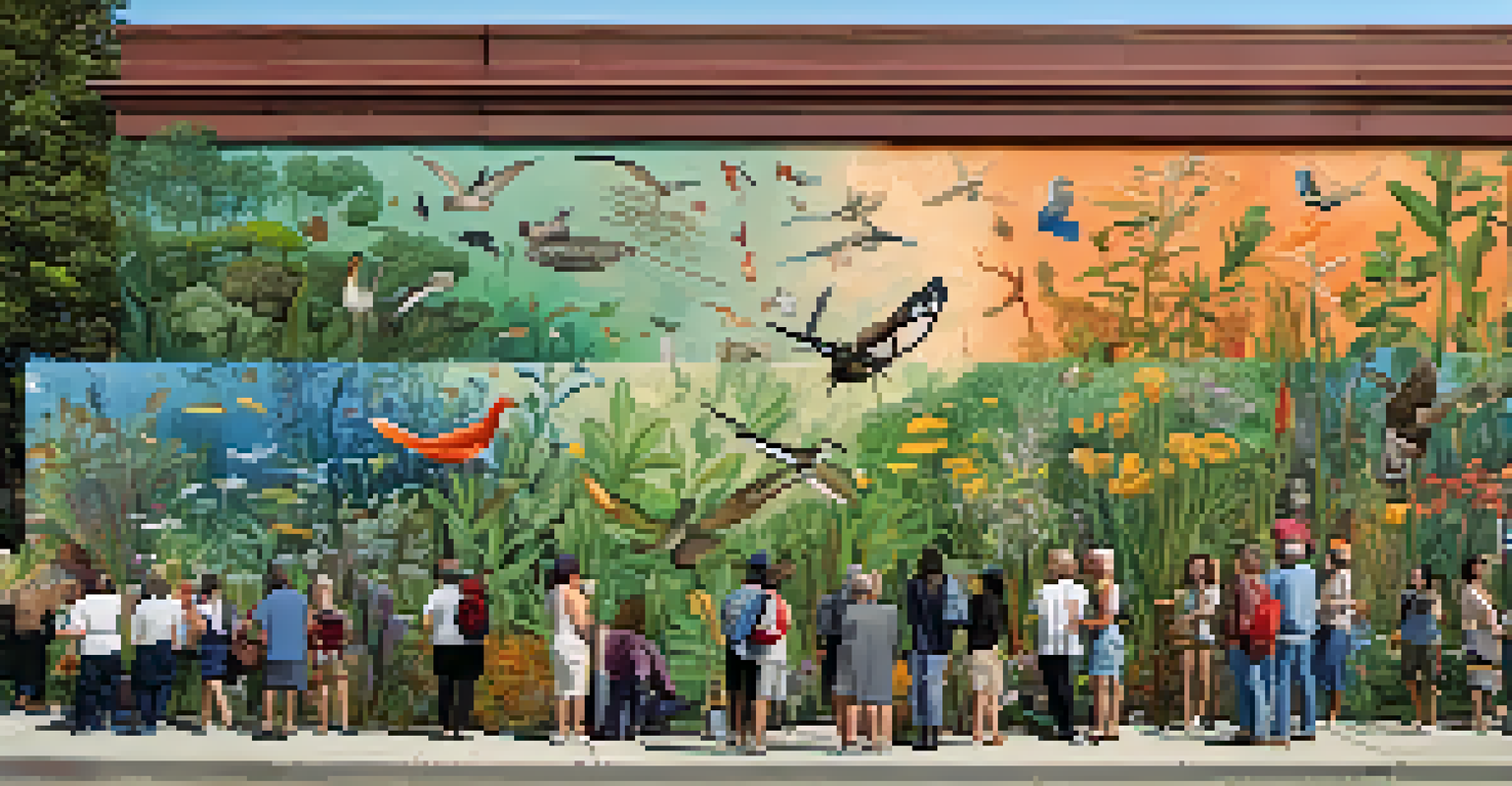The Role of Painting in Highlighting Climate Change Issues

The Historical Connection Between Art and Environmental Issues
Throughout history, art has been a mirror reflecting society's values and struggles, including environmental issues. From the Romantic painters capturing the sublime beauty of nature to contemporary artists highlighting ecological disasters, painting has documented humanity’s relationship with the environment. This historical connection demonstrates how art not only reflects reality but can influence public perception and awareness about climate change.
Art is a way of recognizing ourselves and a way of communicating with the world around us.
For example, artists like John Constable and Claude Monet celebrated the natural world, encouraging viewers to appreciate its beauty. In contrast, modern artists such as Anselm Kiefer and Olafur Eliasson tackle the consequences of climate change through their work, prompting audiences to confront uncomfortable truths. This shift from celebration to confrontation emphasizes the evolving role of art in environmental discourse.
In essence, paintings serve as both a celebration of the Earth’s splendor and a stark reminder of the urgent need for environmental action. As artists continue to explore these themes, they engage viewers in a conversation about the necessity of preserving our planet for future generations.
Art as a Tool for Climate Change Education
Painting can break down complex climate change concepts into digestible visual narratives. By using imagery that resonates emotionally, artists can evoke a deeper understanding of environmental issues than statistics alone. For instance, a striking painting of melting glaciers can powerfully convey the urgency of rising sea levels and their impact on coastal communities.

Moreover, educational initiatives that incorporate art can enhance community engagement. Workshops that encourage participants to express their feelings about climate change through painting not only foster creativity but also promote awareness. This participatory approach makes the issue more relatable and personal, helping individuals connect their experiences to broader environmental challenges.
Art Reflects Environmental Issues
Throughout history, art has mirrored society's changing relationship with the environment, influencing public perception and awareness of climate change.
Ultimately, the visual impact of art can ignite curiosity and inspire action. By transforming abstract concepts into relatable visuals, paintings invite viewers to reflect on their own role in addressing climate change and motivate them to become advocates for environmental stewardship.
The Emotional Power of Visual Art in Climate Advocacy
Paintings have a unique ability to evoke strong emotions, which can be a catalyst for change. An artwork depicting the devastation of a forest fire, for example, can stir feelings of sadness and urgency, prompting viewers to think critically about their own environmental impact. This emotional connection is often more effective than traditional advocacy methods, as it creates a personal stake in the issue.
The greatest threat to our planet is the belief that someone else will save it.
Artists often harness this emotional power to drive home their message, using color, composition, and symbolism to enhance their narrative. For instance, the use of dark colors in a painting of a polluted landscape can evoke feelings of despair, while bright colors in a thriving ecosystem can inspire hope. This dichotomy illustrates the consequences of our actions and the potential for recovery.
By engaging viewers on an emotional level, paintings can inspire action and drive home the importance of climate advocacy. When people feel connected to the issue, they are more likely to participate in meaningful conversations and initiatives aimed at combating climate change.
Public Installations: Art in Public Spaces for Awareness
Public art installations are an innovative way to raise climate change awareness in community spaces. These projects often invite participation from local residents, making the message more impactful and relatable. For example, a large mural depicting a thriving coral reef can serve as a visual reminder of the beauty we stand to lose if we don’t take action against climate change.
Moreover, such installations can provoke thought and discussion among passersby, turning everyday spaces into forums for climate dialogue. When art is displayed in familiar environments, it can challenge individuals to think about their relationship with the environment in a new light. This accessibility fosters a sense of community responsibility towards climate action.
Emotional Art Drives Climate Action
Paintings evoke strong emotions, making them powerful tools for inspiring individuals to connect with and advocate for environmental stewardship.
Ultimately, public art not only beautifies our surroundings but also serves as a vital tool for raising awareness and inspiring collective action. By placing climate change issues front and center in public consciousness, artists can engage a broader audience in the fight for a sustainable future.
Collaborations Between Scientists and Artists
The collaboration between scientists and artists is a growing trend that effectively conveys climate change messages. By combining scientific data with artistic expression, these partnerships can create compelling narratives that resonate with diverse audiences. For instance, an artist may visualize climate data, transforming complex statistics into an engaging visual story that highlights the urgency of the situation.
These collaborations can also lead to innovative projects that enhance public understanding of scientific concepts. Artists can help present research findings in a way that is accessible and engaging, making the information more relatable to the general public. This creative approach can bridge gaps between scientific communities and everyday citizens.
Ultimately, the fusion of art and science has the potential to create a more informed and engaged public. By working together, artists and scientists can craft powerful narratives that not only educate but also inspire action in the fight against climate change.
Art Exhibitions Focused on Climate Change
Art exhibitions that focus on climate change serve as vital platforms for raising awareness and fostering dialogue. These exhibitions provide artists with the opportunity to showcase their work while encouraging visitors to engage with pressing environmental issues. For example, an exhibition featuring artworks related to deforestation can prompt discussions about sustainable practices and conservation efforts.
Additionally, these events often include panels, workshops, and discussions that deepen the audience's understanding of climate change. By bringing together artists, scientists, and activists, these exhibitions create a rich environment for learning and collaboration. They can empower visitors to take action in their own communities and contribute to the global conversation around climate change.
Collaborations Enhance Climate Education
The partnership between artists and scientists creates compelling narratives that effectively communicate the urgency of climate change to diverse audiences.
In this way, art exhibitions become more than just a display of creativity; they transform into interactive experiences that inspire change. By highlighting the urgency of climate issues through powerful visuals, these events encourage a collective commitment to environmental stewardship.
The Future of Painting in Climate Change Advocacy
As climate change continues to escalate, the role of painting in advocacy is likely to evolve further. Artists will continue to experiment with new mediums and technologies, using their creativity to address the ever-changing landscape of environmental issues. This evolution may include digital art, augmented reality, or even interactive installations that engage viewers in new and innovative ways.
Moreover, the increasing focus on climate change in the art world suggests that artists will remain at the forefront of this critical conversation. By exploring various themes, such as sustainability, conservation, and resilience, they will help shape public perception and inspire collective action. As more artists commit to addressing these issues, the impact of their work will continue to expand.

Ultimately, the future of painting in climate change advocacy is bright, with the potential for powerful narratives to emerge. As artists harness their creative talents to amplify the message of climate urgency, they will play an essential role in motivating individuals and communities to take action for a sustainable future.